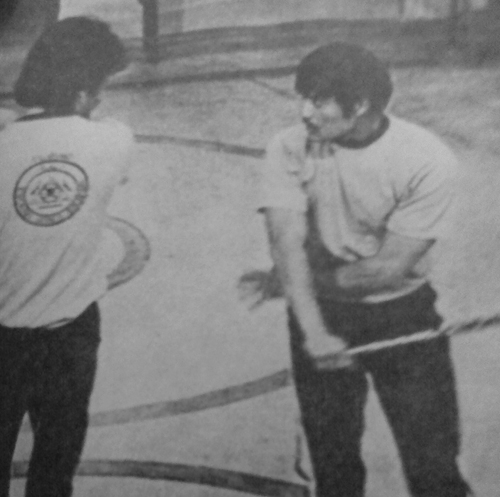Speed is perhaps the most sought-after attributes in the practice of arnis, escrima and kali, collectively known as the Filipino Martial Arts (FMA). But the truth is there is more to speed than the mere acceleration of the business end of the stick from point A to point B. The aim of this article is to provide a comprehensive overview of speed and how to improve it within the framework of FMA practice.
Muscle speed and reaction time
Generally speaking, the shape of a person’s body is the primary indicator of how fast he can move but a heavier determinant is the dominant muscle type that an individual possesses. The distribution of fast and slow twitch muscle fibers in the body may dictate what kind of physical exertion a person may be good at. Simply put, slow twitch muscles are efficient for continuous, extended muscle contractions (the muscles of a marathoner) while fast twitch muscles are good at producing quick bursts of strength or speed (the muscles of a sprinter).
Besides muscle speed, another crucial factor in attaining speed is reaction time, “In addition to muscle speed – what physiologists refer to as movement time – each of us has a distinct reaction time, the interval that elapses from the instant we decide to execute a movement until we are able to start doing so. In many sports particularly those in which quick responses are important, reaction time is the overriding element in overall speed,” wrote James F. Fixx in Maximum “Sports Performance” (1985).
Bruce Lee, known for his legendary speed, puts heavy emphasis on shortening reaction time – the time spent sending a mental command to a muscle to execute a particular move.
Physiologically, reaction time involves the interplay between motor neurons, muscle fibers and the chemical called acetylcholine. The internal process is indeed complex but improving reaction time demands a simple solution – repeated practice, “An athlete’s reaction time, while governed principally by genetic endowment, can be significantly enhanced by practice. Through repeated efforts, we can improve our anticipation – the ability either to guess or to foresee what will happen and to decide what response is likely to be appropriate,” wrote Fixx.
In Filipino stick fighting, both movement speed and reaction time are honed by doing drills like sumbrada and sinawali. The movements were practice slowly at first for the student to learn the proper form but were practiced at high speed later, as mastery of movement dynamics is attained.
Sumbrada and sinawali drills improve muscle speed and reaction time by accustoming the practitioner to high-speed motions. It’s like the experience of getting used to driving a car at 90 mph and then suddenly lowering the speed at 55 mph. Fifty five mph is still fast, but if you’re used to 90 mph, it seems to be a lot slower.
Conditioning and relaxation
A stick fighter’s level of conditioning will affect his ability to generate speed. Fast movements demand quick burst of strength attained through rapid contraction of muscles. A martial artist with questionable level of conditioning is likely to strain or tear a muscle if he attempts to deliver his techniques at maximum speed.
Relaxation is another premium attribute of elite martial artists and athletes. Everyone knows that one cannot move fast while being tensed. Relaxation, besides being the key to high-speed movements also helps reduce fatigue by eliminating unnecessary tensions on muscle groups not used for a particular task.
The ability to relax affects both the physical and mental components of a fighter. Mentally, relaxation results to keener perception and faster reaction time while physically; it produces faster execution of movements.
Therefore, meditation or any practice that teaches relaxation should be an integral part of a martial artist’s training regimen.
Economy of structure and motion
Age will definitely slow down a martial artist and an aging stick fighter would soon realize that the best way to compensate for his loss speed is to practice economy of motion and structure. Economy of motion results to greater speed because all unnecessary movements are eradicated. Taking away needless motions would also result to more reserve strength, and strength, as mentioned earlier is an important component of speed. Economy of structure pertains to the fighter’s stance and positioning in relation to his opponent. Paying attention to economy of structure would allow a fighter to observe and react to his foe’s movements faster and more efficiently.
Perception of time
Advance FMA practitioners wishing to further improve their speed could investigate ways to slow down their perception of time.
Mind science researchers have gathered much data indicating that the key to superior speed is mental not physical. Some experiments in hypnosis have shown that altering a person’s perception of time could have profound effects on physical speed.
Richard Bandler, the co-founder of Neuro-Linguistic Programming (NLP) recalled an interesting incident that occurred during the early founding days of NLP, in his book “Trance Formation,” he wrote, “One young girl even speeded up the way her eyes worked, but not the rest of her, so she could see the world in slow motion. Without any training at all, she was able to run rings around a martial artist friend of mine. From her point of view, everything was slowed all the way down. To the observer, she was moving twice as fast as the other guy.”
In the same line of thought, Keith Floyd in his book “Of Time and the Mind” (1973-1974) hypothesize that the connection between time perception and brainwaves is the reason behind certain superior athletic feats. Taking baseball players as an example, he wrote, “The baseball player firing alpha, for instance, might perceive the ball at no more than half the speed perceived by his teammate firing beta. One firing theta could carefully observe the approach and spin of the ball, examine the stitches, read the label, and have up to four times as much ‘time’ to regulate the swing of the bat and make his moves.”





















